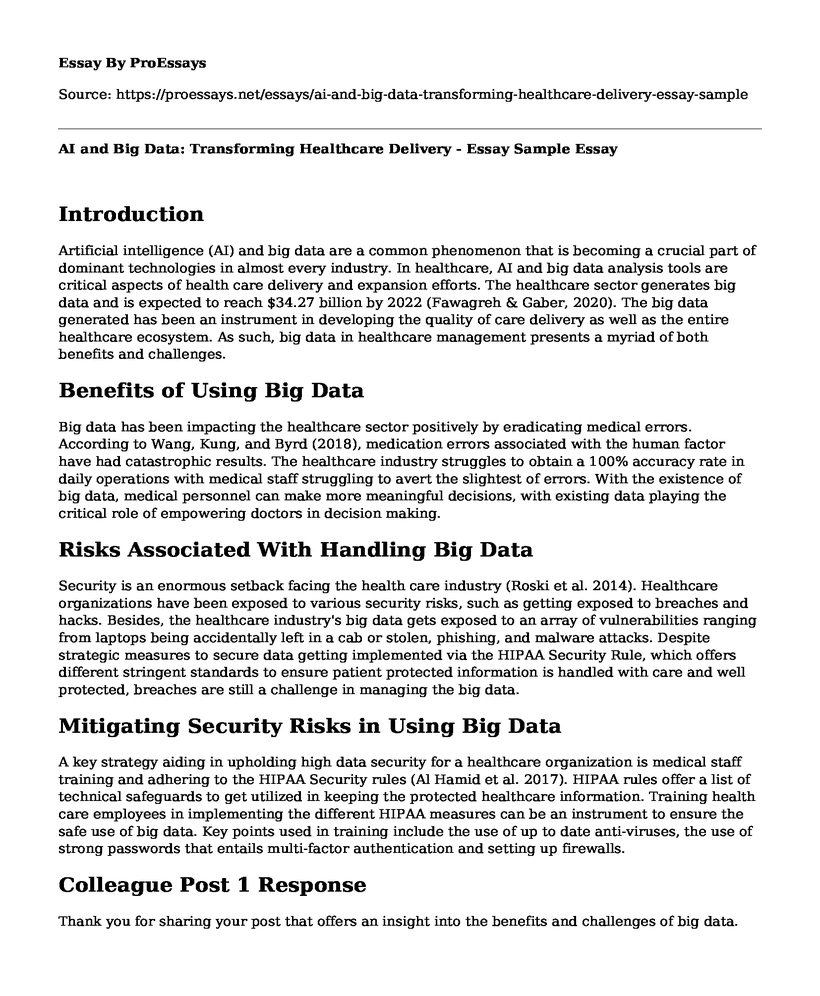Introduction
Artificial intelligence (AI) and big data are a common phenomenon that is becoming a crucial part of dominant technologies in almost every industry. In healthcare, AI and big data analysis tools are critical aspects of health care delivery and expansion efforts. The healthcare sector generates big data and is expected to reach $34.27 billion by 2022 (Fawagreh & Gaber, 2020). The big data generated has been an instrument in developing the quality of care delivery as well as the entire healthcare ecosystem. As such, big data in healthcare management presents a myriad of both benefits and challenges.
Benefits of Using Big Data
Big data has been impacting the healthcare sector positively by eradicating medical errors. According to Wang, Kung, and Byrd (2018), medication errors associated with the human factor have had catastrophic results. The healthcare industry struggles to obtain a 100% accuracy rate in daily operations with medical staff struggling to avert the slightest of errors. With the existence of big data, medical personnel can make more meaningful decisions, with existing data playing the critical role of empowering doctors in decision making.
Risks Associated With Handling Big Data
Security is an enormous setback facing the health care industry (Roski et al. 2014). Healthcare organizations have been exposed to various security risks, such as getting exposed to breaches and hacks. Besides, the healthcare industry's big data gets exposed to an array of vulnerabilities ranging from laptops being accidentally left in a cab or stolen, phishing, and malware attacks. Despite strategic measures to secure data getting implemented via the HIPAA Security Rule, which offers different stringent standards to ensure patient protected information is handled with care and well protected, breaches are still a challenge in managing the big data.
Mitigating Security Risks in Using Big Data
A key strategy aiding in upholding high data security for a healthcare organization is medical staff training and adhering to the HIPAA Security rules (Al Hamid et al. 2017). HIPAA rules offer a list of technical safeguards to get utilized in keeping the protected healthcare information. Training health care employees in implementing the different HIPAA measures can be an instrument to ensure the safe use of big data. Key points used in training include the use of up to date anti-viruses, the use of strong passwords that entails multi-factor authentication and setting up firewalls.
Colleague Post 1 Response
Thank you for sharing your post that offers an insight into the benefits and challenges of big data. The identified primary problem is the inability to share EHR data across the board with other clinicians to aid in decision making. A critical approach to enhance the sharing of big data across the EHR is adopting information technology that will facilitate the creation of network linkages (Keller et al. 2015). Having a network where all EHR medical personnel can log into and share data can ease the transfer of information. It will aid and allow clinicians to analyze critical information and support critical decisions.
Colleague Post 2 Response
Thank you for sharing your significant data posting offering the use of new technologies in sharing big data. I agree with your posting that rapid advances in technology can leave many nurses frustrated as they try to adapt to the usability of the new technologies. Information technology competence in health care can get enhanced via training medical personnel that interacts with the latest technologies (Kruse et al. 2016). The training does not only improve technological interaction and ease of use but also eliminate vulnerabilities loopholes associated with technology since the staff gets trained on how to mitigate and avoid technological risks.
References
Al Hamid, H. A., Rahman, S. M. M., Hossain, M. S., Almogren, A., & Alamri, A. (2017). A security model for preserving the privacy of big medical data in a healthcare cloud using a fog computing facility with pairing-based cryptography. IEEE Access, 5, 22313-22328. https://ieeexplore.ieee.org/abstract/document/8052485/
Fawagreh, K., & Gaber, M. M. (2020). Resource-efficient fast prediction in healthcare data analytics: A pruned Random Forest regression approach. Computing, 1-12. https://link.springer.com/content/pdf/10.1007/s00607-019-00785-6.pdf
Keller, M. E., Kelling, S. E., Cornelius, D. C., Oni, H. A., & Bright, D. R. (2015). Enhancing practice efficiency and patient care by sharing electronic health records. Perspectives inhealth informationmanagement, 12(Fall). https://www.ncbi.nlm.nih.gov/pmc/articles/PMC4632871/
Kruse, C. S., Goswamy, R., Raval, Y. J. & Marawi, S. (2016). Challenges and opportunities of big data in health care: a systematic review. JMIR medical informatics, 4(4), e38. https://medinform.jmir.org/2016/4/e38/?utm_campaign=JMIR_TrendMD_0&utm_medium=cpc&utm_source=TrendMD
Roski, J., Bo-Linn, G. W., & Andrews, T. A. (2014). Creating value in health care through big data: opportunities and policy implications. Health Affairs, 33(7), 1115-1122. https://www.healthaffairs.org/doi/abs/10.1377/hlthaff.2014.0147
Wang, Y., Kung, L., & Byrd, T. A. (2018). Big data analytics: Understanding its capabilities andpotential benefits for healthcare organizations. Technological Forecasting and Social Change, 126, 3-13.https://www.sciencedirect.com/science/article/pii/S0040162516000500
Cite this page
AI and Big Data: Transforming Healthcare Delivery - Essay Sample. (2023, Apr 25). Retrieved from https://proessays.net/essays/ai-and-big-data-transforming-healthcare-delivery-essay-sample
If you are the original author of this essay and no longer wish to have it published on the ProEssays website, please click below to request its removal:
- Essay Example on Cybersecurity Issues
- Paper Example on Impact of Nanotechnology in Civil Engineering
- Should Ill People Do an Internet Research of Their Condition? Essay
- Personal Statement on Technology and Digital Use in the Education Sector
- Google Voice Assistant Issues: Solutions & Implementation Plans
- Essay Example on Wind Turbines: Safe Renewable Energy for Climate and Human Health
- Microsoft vs. Google and Apple: The Software War - Essay Sample







